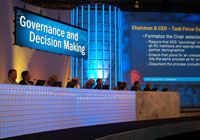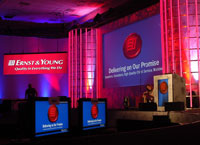- Ernst & Young's tagline--"Quality In Everything We Do"--explains the technology-rich show the company produced for its International Partners' Meeting. Known as a global leader in professional services, the company is committed to restoring the public's trust in professional services firms and in the quality of financial reporting. On September 25, 2005, more than 3,500 international and Americas Partners came together for a three-day period at Gaylord Palms Convention Center in Orlando to discuss future goals, share best practices and experience the company's commitment to quality.
The set included Plasma panel monitors for the presenters on stage.
The theme of the meeting was "Delivering on Our Promise." Ken Mac Donald, executive producer for Ernst & Young Staging, secured the services of LMG, Inc. to provide the right equipment and manpower to help him achieve the goal of the meeting.
LMG, Inc. provided the video and audio support throughout the event-with the most technology we have ever used in a single show. "Our mix of media formats was unlike any show I've ever done before," said 25-plus-year industry veteran Bob Murdock, video services manager for LMG.
The set included Plasma panel monitors for the presenters on stage.
The technology used to convey the message was state-of-the-art. The stage was equipped with Versa TILE's, Versa TUBE's (from Element Labs) and Barco LED walls, which were programmed by John Ballentyne of Ballentyne Brumble Communications, to support the visual message of the meeting.
We provided a wide arrangement of cutting-edge technology to support Ernst & Young's overall goal of providing a crisp, clean and high-tech program to engage the international audience. The technology included superwidescreen and Stewart Filmscreen Lumiflex seamless screens, Vista Systems Spyder system, Meyer Sound MICA loudspeaker system, Midas Heritage 3000 mixing console, Snell & Wilcox Kahuna switcher, and HD projection from Digital Projection and Christie Digital.
The Set Up
On the video side, we had five screens. In the center, we used a 20-foot by 66-foot, eight-inch superwidescreen, from Stewart Filmscreen, that was edge-blended with an aspect ratio of 3.33:1. The Spyder was on deck to feed the screen through multiple side-by-side projectors. Two 12-foot x 21.5-foot side screens and two 16-foot x 9-foot delay screens displayed high-definition graphics, and all the cameras and switching were in HD.

A few of the show segments included large panel discussions with 12 panelists (who were pre-set behind the superwidescreens) on each side of the stage. When the time came, the screen flew up, the panel rolled out into place, and then the screen dropped behind the panel to display a virtual set. The tile effect in the foreground is done with Versa TILE from Element Labs.
Coupled with the stunning visuals, the audio component sealed the deal. We used the Meyer Sound MICA system for house PA along with the Midas Heritage 3000 mixing console front of house.
"The MICA serves as an excellent substitute for larger line array systems when size and weight are a concern," explained Kevin Bridges, LMG's audio services manager. "Its power-to-size ratio is staggering."
Integration
Our pre-planning stage was especially important because of the massive amount of technology we incorporated into the show. Using superwidescreen and HD took a well thought-out plan. When using these, we consult with clients before they even begin to create graphics to make sure the formats are compatible with the equipment. We pixel match all of our sources to the output resolution for the clearest, most pure image. "It truly looks 3D," explained Dave Divis, show technician for LMG.
With two switching systems and all the other gear involved, we turned to the Dataton show control system. The computer-based system enabled us to remotely cue multiple devises on a timeline. We programmed the Dataton to control the Doremi and the Versa TILE and Versa TUBE elements to change simultaneously on cue. In addition, we had operators on the Vista Spyder system and Snell & Wilcox Kahuna with a stage manager calling the show.
The Dataton allowed us to sync time code to the lighting console to affect the lighting changes specifically. For example, the lights, video and audio were programmed to begin and stop at certain times, all orchestrated and timed perfectly with the other elements.
Transition
Speaker transitions are a good example of how the Dataton system helped out. For each show segment, we had an intense scenery and set change. Each speaker had his or her own: (1) "power word" to emphasize the topic; (2) color palette; (3) moving background fed into the Versa TILEs, Versa TUBEs and superwidescreen; (4) title screens fed to the HD screens. All of these components were precisely timed out and built up to the speaker's appearance on stage.
@copy:A few of the show segments included large panel discussions with 12 panelists (who were pre-set behind the superwidescreens) on each side of the stage. When the time came, the screen flew up, the panel rolled out into place, and then the screen dropped behind the panel to display a virtual set.










